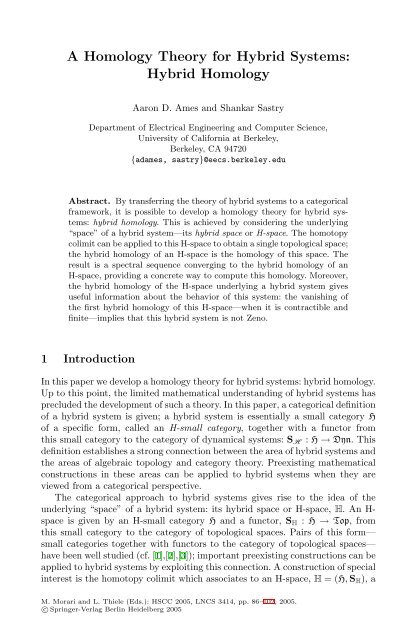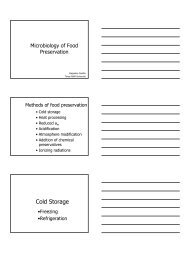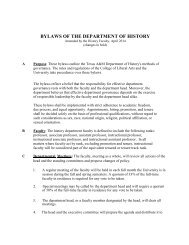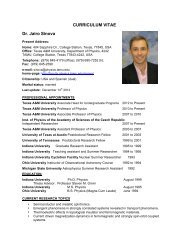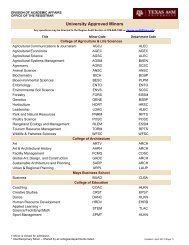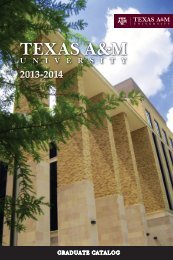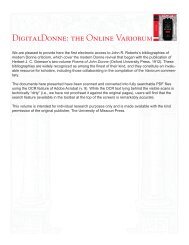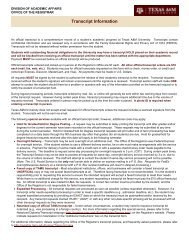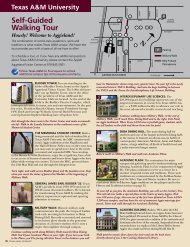A Homology Theory for Hybrid Systems: Hybrid Homology - CiteSeerX
A Homology Theory for Hybrid Systems: Hybrid Homology - CiteSeerX
A Homology Theory for Hybrid Systems: Hybrid Homology - CiteSeerX
You also want an ePaper? Increase the reach of your titles
YUMPU automatically turns print PDFs into web optimized ePapers that Google loves.
88A.D. Ames and S. Sastry2 Categorical <strong>Hybrid</strong> <strong>Systems</strong>Up to this point, a hybrid system has been defined to be a tuple which is a collectionof spaces subject to certain relations given by maps between these spaces.A set of vector fields or flows is also included in the definition. To better understandhybrid systems, we consider this collection of spaces and this collection offlows separately; the <strong>for</strong>mer is referred to as a hybrid space or H-space and thelatter is a “flow” on this H-space. The motivation <strong>for</strong> this is derived from dynamicalsystem theory where there is a clear distinction between the “underlyingtopological space” of a dynamical system and a flow on that space. Parallelingdynamical systems, a hybrid system is obtained by adding a collection of flowsto an H-space.In this section, we give the classical definition of an H-space and then proceedto give a categorical definition of an H-space in terms of a small category and afunctor; the advantage of the categorical definition of an H-space is that it is notonly more general but also more concise. We then proceed to give the definition ofa hybrid system utilizing the categorical framework developed—a hybrid systemis also defined by a small category and a functor. These constructions will beessential in developing a homology theory <strong>for</strong> hybrid systems, although this seemsto be only the first step in exploring their power.H-Space. Define a classical H-space (short <strong>for</strong> classical hybrid space) as a tupleH class =(Q, E, D, G, R)where– Q = {1, ..., m} ⊂Z is a set of discrete states.– E ⊂ Q × Q is a set of edges which define relations between the domains. Fore =(i, j) ∈ E, we denote the source of e by s(e) =i and the target of e byt(e) =j.– D = {D i } i∈Q is a set of domains where D i is a topological space.– G = {G e } e∈E is a set of guards, where G e ⊆ D s(e) is also a topological space.– R = {R e } e∈E is a set of reset maps or transition maps; these are continuousmaps from G e ⊆ D s(e) to R e (G e ) ⊆ D t(e) .The subscript “class” indicates that this is a “classical” definition, meaning thatthis definition is one of the most commonly used ones (cf. [5]). For a classical H-space the pair (Q, E) is an oriented graph (technically a pseudograph), so we canwrite a classical H-space as a tuple H class =(Γ, D, G, R). The graph Γ =(Q, E)is referred to as the underlying graph of the H-space.We can demand that the collection of topological spaces D be a collection ofmanifolds M = {M i } i∈Q , that the maps R be a collection of smooth embeddingsR S , and that the set of guards be a set of smooth manifolds, G M , such thatG M e is an embedded submanifold of M s(e) . In this case we call the H-spaceG class =(Q, E, M, G M ,R S )asmooth classical hybrid space or a smooth classicalH-space or a classical G-space. This more restrictive definition is the startingpoint <strong>for</strong> much of the literature on hybrid systems.
A <strong>Homology</strong> <strong>Theory</strong> <strong>for</strong> <strong>Hybrid</strong> <strong>Systems</strong>: <strong>Hybrid</strong> <strong>Homology</strong> 89Example 1. The hybrid system modeling a water tank system (cf. [5] <strong>for</strong> a completeexplanation, although we assume the reader is familiar with this example)is a classical example of a hybrid system that displays Zeno behavior. Beyondthis observation, we will not discuss the dynamics of this hybrid system as inthis paper we are more interested in its underlying “space”. The hybrid space<strong>for</strong> the water tank will be denoted by H W class =(Γ W ,D W ,G W ,R W ). It has as itsunderlying graph Γ W given by the diagram1e 1✲✛e22The other elements of the hybrid system are defined as: D W 1 = D W 2 = {(x 1 ,x 2 ):x 1 ,x 2 ≥ 0}, G W e 1= {(x 1 , 0) : x 1 ≥ 0}, G W e 2= {(0,x 2 ) : x 2 ≥ 0}, andR W e 1(x 1 ,x 2 )=R W e 2(x 1 ,x 2 )=(x 1 ,x 2 ). We will refer back to this example throughoutthis paper in order to illustrate the concepts being introduced.H-Small Categories. An H-small category is a small category H (cf. [6] <strong>for</strong>more in<strong>for</strong>mation on small categories and category theory in general) satisfyingthe following conditions:1. Every object in H is either the source of a non-identity morphism in H or thetarget of a non-identity morphism but never both, i.e., <strong>for</strong> every diagrama 0α 1✲ a1α 2✲ ···α n✲ anin H, all but one morphism must be the identity (the longest chain of composablenon-identity morphisms is of length one).2. If an object in H is the source of a non-identity morphism, then it is thesource of exactly two non-identity morphisms, i.e., <strong>for</strong> every diagram in Hof the <strong>for</strong>ma 1✛ α1a 2✛ α2a 3either all of the morphisms are the identity or two and only two morphismsare not the identity.Important Objects in H-Small Categories. Let H be an H-small category.We use Ob(H) to denote the objects of H and Mor id/ (H) to denote the non-identitymorphisms of H; all of the morphisms in H are the union of these morphismswith the identity morphism from each object to itself. For a morphism α : a → bin H, its source is denoted by s(α) =a and its target is denoted by t(α) =b. ForH-small categories, there are two sets of objects that are of particular interest;these are subsets of the set Ob(H). The first of these is called the wedge set,denoted by ∧(H), and defined to be∧(H) :={a ∈ Ob(H) : a = s(α), a = s(β), α,β ∈ Mor id/ (H), α ≠ β}.✛ α3a 0αn ✲· · · · · · · · ·a n
90A.D. Ames and S. SastryFor all a ∈∧(H) there are two and only two morphisms (which are not theidentity) α, β ∈ Mor id/ (H) such that a = s(α) anda = s(β), so we denote thesemorphisms by α a and β a . Conversely, given a morphism γ ∈ H (which is notthe identity), there exists a unique a ∈∧(H) such that γ = α a or γ = β a .Thesymbol ∧ is used because every object a ∈∧(H) sits in a diagram of the <strong>for</strong>m:a = s(α a ) = s(β a )b = t(α a )✛ α aβ a✲c = t(β a )Note that giving all diagrams of this <strong>for</strong>m (of which there is one <strong>for</strong> each a ∈∧(H)) gives all the objects in H, i.e., every object of H is the target of α a or β a ,or their source, <strong>for</strong> some a ∈∧(H). In particular, we can define ∨(H) =(∧(H)) cwhere (∧(H)) c is the complement of ∧(H) in the set Ob(H).Definition 1. A categorical H-space is a pair H cat =(H, S H ) where H is anH-small category and S H : H → Top is a functor such that <strong>for</strong> every diagram ofthe <strong>for</strong>mA ✛ α E β ✲ Bin H in which α and β are not the identity, either S H (α) or S H (β) is an inclusion.Theorem 1. There is an injective correspondence{Classical H − spaces, H class }−→{Categorical H − spaces, H cat }This is a bijective correspondence if H has a finite number of objects.Example 2. The categorical hybrid space <strong>for</strong> the water tank, H W cat =(H W , S W H )is defined by the following diagram:b✛ αa✛βda S W H (a) = GW e 1dβ a✲α d✲cS W H✲ SWH (b) = D W 1✛ SW H (α a) = id✛S W H (β d) = idS W H (d) = G W e 2S W H (β a) = id ✲S W H (c) = D W 2✲S W H (α d) = idNote that the H-small category H W is defined by the diagram on the left togetherwith the identity morphism on each object, while the functor S W H is defined by
A <strong>Homology</strong> <strong>Theory</strong> <strong>for</strong> <strong>Hybrid</strong> <strong>Systems</strong>: <strong>Hybrid</strong> <strong>Homology</strong> 91the diagram of topological spaces on the right. To complete the description ofthe functor S W H , on identity morphisms SW H is defined to be the identity map.Smooth Categorical <strong>Hybrid</strong> Spaces. We can define a categorical G-spacein a way analogous to the definition of a categorical H-space, i.e., it is a pairG cat =(H, T G ), where H is an H-small category and T G is a functor T G : H →Man from H to the category of manifolds, such that the pair (H, I ◦ T G ) is alsoa categorical H-space; here I : Man → Top is the inclusion functor. With thisdefinition, Theorem 1 yields the following corollary.Corollary 1. There is an injective correspondence{Classical G − spaces, G class }−→{Categorical G − spaces, G cat }The Category of Dynamical <strong>Systems</strong>. We can consider both the categoryof dynamical systems and the category of smooth dynamical systems. The categoryof dynamical systems, denoted by Dyn, has as objects dynamical systemsand dynamical subsystems. A dynamical system is a pair (X, ϕ) where X is atopological space and ϕ is a flow on that topological space—more precisely, thisis a local flow (cf. [7]). A morphism of two dynamical systems α :(X, ϕ) → (Y,ψ)in this category is defined by a pair α =(h, r) of continuous maps, h : X → Yand r : R → R, such that the following diagram˜X ϕ ⊂ X × R h × r ✲ Ỹψ ⊂ Y × Rϕ❄Xh✲ Yψ❄commutes, i.e., h(ϕ t (x)) = ψ r(t) (h(x)); here ˜X ϕ is the maximal flow domainof the flow ϕ (as defined in [7]). Clearly, from this definition it follows that twodynamical systems are isomorphic (in the categorical sense) if and only if they aretopologically orbital equivalent. A dynamical subsystem is a pair (U ⊆ X, ϕ| U )where U is a topological space contained in X and ϕ| U is the restriction of a flowϕ on X to U; we say that this dynamical subsystem is a subsystem of (X, ϕ).Morphisms of dynamical subsystems are defined in a way analogous to thedefinition of morphisms of dynamical systems (cf. [8] <strong>for</strong> a definition).Similarly, we can define the category Sdyn of smooth dynamical systemswhose objects are smooth dynamical systems and smooth dynamical subsystems.1 A smooth dynamical system is a pair (M,V ) where M is a manifold andV is a vector field on that manifold (both of which are smooth). A morphismbetween smooth dynamical systems α =(f,F) :(M,V ) → (N,W) is given bysmooth maps, f : M → N and F : TM → TN, such that the diagram1 This definition is a generalization of the one given in [9], although there it was definedas the category of dynamical systems and not smooth dynamical systems.
92 A.D. Ames and S. SastryMf ✲ NV❄ F✲TNW❄TMcommutes, and <strong>for</strong> each p ∈ M the restriction of F to the fiber T p M, F | TpM :T p M → T f(p) N, is linear. In the case when F is the push<strong>for</strong>ward of f, i.e.,F = f ∗ , this definition implies that V and W are f-related (cf. [7]). A smoothdynamical subsystem is a pair (S ⊆ M,V | S ) where S is an embedded submanifoldof M and V | S is the restriction of a vector field V on M to S, andhence a vector field along S. As in the case of dynamical systems, morphisms ofsmooth dynamical subsystems are given in a way analogous to the definition ofmorphisms of dynamical systems (cf. [8] <strong>for</strong> a definition).Note that there is a projection functor P Top : Dyn → Top from the categoryof dynamical systems to the category of topological spaces given by P Top (X, ϕ) =X on objects and P Top (h, r) =h on morphisms. Similarly, we have a projectionfunctor from the category Sdyn to the category Man, P Man : Sdyn → Mandefined in an analogous way.<strong>Hybrid</strong> <strong>Systems</strong>. With the definitions of dynamical systems and smooth dynamicalsystems in hand, we can define hybrid systems. A classical hybrid systemis a tuple H class =(H class ,Φ)=(Q, E, D, G, R, Φ) where H class is a classical H-space and Φ = {ϕ i } i∈Q where ϕ i is a flow on the topological space D i , i.e.,(D i ,ϕ i ) is a dynamical system <strong>for</strong> each i ∈ Q.Similarly, we can define smooth classical hybrid systems as pairs G class =(G class ,V)=(Q, E, M, G M ,R S ,V) where G class is a classical G-space and V ={V i } i∈Q where V i is a smooth vector field on the manifold M i , i.e., (M i ,V i )isasmooth dynamical system <strong>for</strong> each i ∈ Q.Definition 2. A categorical hybrid system is a pair H cat = (H, S H ) whereH is an H-small category and S H : H → Dyn is a functor such that the pair(H, P Top ◦ S H ) is a categorical H-space. The H-spaceH H =(H, P Top ◦ S H ):=(H, S H H )is referred to as the underlying H-space of the hybrid system H cat .Theorem 2. If <strong>for</strong> each e ∈ E there exists a morphism of dynamical sub-systemsα e :(G e ⊆ D s(e) ,ϕ s(e) | Ge ) → (R e (G e ) ⊆ D t(e) ,ϕ t(e) | Re(G e)),then there is an injective correspondence{Classical <strong>Hybrid</strong> <strong>Systems</strong>, H class }−→{Categorical <strong>Hybrid</strong> <strong>Systems</strong>, H cat }.
A <strong>Homology</strong> <strong>Theory</strong> <strong>for</strong> <strong>Hybrid</strong> <strong>Systems</strong>: <strong>Hybrid</strong> <strong>Homology</strong> 93Smooth Categorical <strong>Hybrid</strong> <strong>Systems</strong>. As in the case of categorical hybridsystems, we can define a smooth categorical hybrid system. A smooth categoricalhybrid system is a pair G cat =(H, T G ) where H is an H-small category andT G : H → Sdyn is a functor such that the pair (H, P Man ◦ T G ) is a categoricalG-space. As be<strong>for</strong>e, the underlying G-space of a smooth hybrid system G cat isgiven byG G =(H, P Man ◦ T G ):=(H, T G G ).With this notation there is the following corollary of Theorem 2.Corollary 2. If <strong>for</strong> each edge e ∈ E there exists a morphism of smooth dynamicalsubsystemsα e :(G e ⊆ M s(e) ,V s(e) | Ge ) → (R e (G e ) ⊆ M t(e) ,V t(e) | Re(G e)),then there is an injective correspondence{Smooth Classical <strong>Hybrid</strong> <strong>Systems</strong>, G class }↓{Smooth Categorical <strong>Hybrid</strong> <strong>Systems</strong>, G cat }.Remark 1. Because of Theorem 1 and 2, we use H and H to denote categoricalhybrid spaces and hybrid systems, respectively, and simply refer to them ashybrid spaces and hybrid systems. Similarly, because of Corollary 1 and 2 weuse G and G to denote smooth categorical hybrid spaces and systems; we simplyrefer to them as smooth hybrid spaces and systems.The Categorical Framework <strong>for</strong> <strong>Hybrid</strong> <strong>Systems</strong>. To conclude this section,we note that the categorical framework introduced here gives a unifyingframework <strong>for</strong> all of the definitions introduced here. More specifically, fixingan H-small category H, an H-space, G-space, hybrid system or smooth hybridsystem is just given by the following functorsH S H→ Top,H T G→ Man, H S →HDyn, H T G→ Sdyn,respectively. Namely, all that changes is the functor and the target category.Here the H-small category can be thought of as the “discrete” component ofthe hybrid system and the functor can be thought of as the “continuous” component.This general framework indicates that in studying hybrid systems, oneneed only consider functors from small categories to other categories. Note thatthis categorical notion of hybrid systems, hybrid spaces, et cetera, makes easywork of defining the category of hybrid systems and hybrid spaces. Studyingthe properties of these categories would seem to be a promising area of futureresearch in hybrid systems.
94A.D. Ames and S. Sastry3 <strong>Hybrid</strong> <strong>Homology</strong>In this section, a homology theory <strong>for</strong> hybrid systems is developed. Recall fromSection 2 that every hybrid system has an underlying “space,” termed an H-space. With every H-space, we can associate a single topological space throughthe use of the homotopy colimit; the homology of this space is defined to be thehybrid homology of an H-space. Fortunately, there is a spectral sequence convergingto the hybrid homology of an H-space. It will be seen that this spectralsequence implies a series of short exact sequences computing the hybrid homologyin terms of the homology of a small category with coefficients in a certainfunctor. In the case when the H-space is contractible, the hybrid homology ofthis H-space is just the homology of a certain small category with coefficients inan abelian group.The Homotopy Colimit. Let C be a small category and F : C → Top afunctor from this category to the category of topological spaces. There are twowell known ways to associate to such a pair a single topological space. The first,and more obvious way, is through a construction known as the colimit. This isdefined ascolim C (F) =∐a∈Ob(C) F(a)x ∼ F(α)(x) ,α ∈ Mor id/ (C).This construction has been used in the past in hybrid systems, namely in [5],although it was not recognized that this was actually the colimit as the categoricaldefinition of hybrid systems was not available in that paper; the hybrifoldwas defined as colim H (S) <strong>for</strong> an H-space H =(H, S) (<strong>for</strong> the rest of the paper wedrop the “H” subscript, i.e., we take S = S H ). The key point is that althoughthis construction is the obvious way of associating a single space to a hybridsystem, it does not seem to be the “correct” one. There are many ways to justifythis statement. In the context of algebraic topology, it has been known <strong>for</strong> a longtime that the colimit does not possess desirable properties with respect to homotopiesof spaces. A more subtle argument follows by considering the homology ofthese spaces; the colimit does not seem to encode the correct in<strong>for</strong>mation aboutthe behavior of hybrid systems—namely, with respect to Zeno. This problem isrooted in the fact that the colimit “<strong>for</strong>gets” about the in<strong>for</strong>mation encoded inthe edges of a hybrid system.There is another, albeit more complicated, way of associating a single topologicalspace to a hybrid system—through the homotopy colimit. This constructionseems to encode the correct in<strong>for</strong>mation about the hybrid system, both with respectto homotopies (cf. [1],[3]) and with respect to homology. For this reason wefocus on the homotopy colimit. For simplicity, we will not introduce the definitionof the homotopy colimit but refer the interested reader to [1] <strong>for</strong> a completetutorial on homotopy colimits. The pertinent point regarding homotopy colimitsis the simple <strong>for</strong>m that they take when considering H-spaces.
A <strong>Homology</strong> <strong>Theory</strong> <strong>for</strong> <strong>Hybrid</strong> <strong>Systems</strong>: <strong>Hybrid</strong> <strong>Homology</strong> 95Fig. 1. The colimit and homotopy colimit of the water tank hybrid spaceTheorem 3. For an H-space H =(H, S),( ∐ ) ( ∐ )hocolim H b∈∨(H) S(b) ∐a∈∧(H) (S(a) × I) (S) =.(x, 0) ∼ S(α a )(x), (x, 1) ∼ S(β a )(x)Example 3. For the water tank hybrid space H W =(H W , S W ), the colimit ishomotopic to the (2-dimensional) cone, while the homotopy colimit is homotopicto the punctured cone (see Figure 1). It will be seen that the “hole” in this coneis a warning that the hybrid system may be Zeno, i.e., if the hole was not present,the hybrid system could not be Zeno—the topology of this space dictates thetypes of behavior this hybrid system can display.The Underlying Topological Space of an H-Space. Since the homotopycolimit is a single topological space, we can define the underlying topologicalspace of an H-space asTop(H) := hocolim H (S)and we can consider the homology of this space. More explicitly, this gives adefinition of hybrid homology—the homology of an H-space. The authors believethat this space will prove useful <strong>for</strong> other constructions on hybrid systems.Definition 3. The homology of an H-space H =(H, S), denoted by HH i (H,A)and termed the hybrid homology of H with coefficients in an abelian group A, isdefined to beHH i (H,A):=H i (Top(H),A)=H i (hocolim H (S),A).The Homotopy Colimit Spectral Sequence. One of the important benefitsof considering homotopy colimits is the homotopy colimit spectral sequence (cf.[1]) that relates the homology of the homotopy colimit to that of the homologyof the underlying small category with coefficients in a functor. Note that there isnot a similar spectral sequence <strong>for</strong> the colimit; this alone motivates the use of the
96A.D. Ames and S. Sastryhomotopy colimit. Specifically, <strong>for</strong> a small category C and functor F : C → Top,there is a spectral sequenceE 2 p,q = H p (C,H q (F,A)) ⇒ H p+q (hocolim C (F),A).Here A is an abelian group and H q (F,A):C → Ab is the functor from the smallcategory to the category of abelian groups obtained by composing the homologyfunctor H q (−,A):Top → Ab with F. The homology H p (C,H q (F,A)) is thehomology of the small category C with coefficients in the functor H q (F,A). Fora review of this homology theory, we refer the reader to [1], [10] and [11].In the case of an H-space H =(H, S) this spectral sequence gives us importantin<strong>for</strong>mation about the underlying topological space of the hybrid system,Top(H). In this case the spectral sequence becomesE 2 p,q = H p (H,H q (S,A)) ⇒ HH p+q (H,A),and we refer to this spectral sequence as the hybrid homology spectral sequence.Because H is an H-small category, and by definition the longest chain of composablenon-identity morphisms is of length one, <strong>for</strong> any functor L : H → Ab,H n (H, L) =0,<strong>for</strong> n ≥ 2. This implies that the spectral sequence will simplify even further intoa set of short exact sequences.Short Exact Sequences from a Spectral Sequence. Suppose that there isa spectral sequence E 2 p,q ⇒ H p+q .IfE 2 p,q = 0 except when p =0, 1 then thereare short exact sequences0 −→ E 2 1,n−1 −→ H n −→ E 2 0,n −→ 0<strong>for</strong> all n ≥ 0 (cf. [12]). Because H n (H, L) =0<strong>for</strong>n ≥ 2 and any functor L : H →Ab, <strong>for</strong> the hybrid homology spectral sequence E 2 p,q = H p (H,H q (S,A)) = 0 <strong>for</strong>p ≠0, 1. There<strong>for</strong>e, we have established the following important theorem.Theorem 4. For an H-space H =(H, S) and an abelian group A, there areshort exact sequences0 −→ H 1 (H,H n−1 (S,A)) −→ HH n (H,A) −→ H 0 (H,H n (S,A)) −→ 0.Collapsing Spectral Sequences. For a spectral sequence Ep,q2 ⇒ H p+q ,ifEp,q 2 = 0 except when q = 0, then the spectral sequence is said to collapse. Inthis case there is an isomorphism H n∼ = E2n,0 . This isomorphism will yield thetheorem shown below, which will be used in the following section to establish avery concrete method <strong>for</strong> computing the hybrid homology of an H-space in thecase when the hybrid homology spectral sequence collapses. This will happen <strong>for</strong>a special class of hybrid systems, as given in the following definition.
A <strong>Homology</strong> <strong>Theory</strong> <strong>for</strong> <strong>Hybrid</strong> <strong>Systems</strong>: <strong>Hybrid</strong> <strong>Homology</strong> 97Definition 4. The H-space H =(H, S) is contractible if S(a) is contractible<strong>for</strong> every a ∈ Ob(H) and S(α) ∼ id <strong>for</strong> every α ∈ Mor id/ (H) (here ∼ denoteshomotopic). We say that H is finite if H has a finite number of objects andhence a finite number of morphisms. The H-space H is connected if Top(H) isconnected.Theorem 5. If the H-space H =(H, S) is contractible, thenHH i (H,A) ∼ = H i (H,A)<strong>for</strong> an abelian group A. It follows that HH n (H,A)=0<strong>for</strong> n ≥ 2.4 Morse <strong>Theory</strong> and the Euler Characteristic of HIt is interesting to note that we can define the Euler characteristic <strong>for</strong> an H-spaceH. Moreover, it will be seen that the Euler characteristic of an H-space can beexpressed as a combination of the Euler characteristics of individual topologicalspaces in the hybrid space. As an application, a Morse theory type of theoremcan be established <strong>for</strong> hybrid systems in a very special case.The Euler Characteristic. Let F be a field. Since Top(H) is a topologicalspace, we can define the Euler characteristic of the hybrid homology of an H-space in the usual fashion. If dim F HH i (H, F) is finite and nonzero <strong>for</strong> only afinite number of i ′ s (here the dimension of HH i (H, F) is its dimension as a vectorspace over F), then the Euler characteristic of H with coefficients in a field F isgiven by∞∑χ(H, F) = (−1) i dim F HH i (H, F).i=0The Euler characteristic also can be defined when considering HH i (H); sincethis is not a vector space, the Euler characteristic is defined using the rank of anabelian group. For an abelian group A, define its rank (over Z) byrank Z (A) =dim Q (A ⊗ Z Q). In this case the Euler characteristic is defined to be∞∑∞∑χ(H) = (−1) i rank Z HH i (H) = (−1) i dim Q HH i (H) ⊗ Z Q,i=0where, again, <strong>for</strong> this to be well–defined, HH i (H) ⊗ Z Q must be a finite dimensionalvector space and nonzero <strong>for</strong> only a finite number of i ′ s.The main theorem of this section is that the Euler characteristic of an arbitraryH-space can be computed in terms of the Euler characteristic of thetopological spaces that determine the H-space, i.e., the topological space S(a)<strong>for</strong> a ∈ Ob(H). This theorem yields a corollary that allows <strong>for</strong> the easy computationof the Euler characteristic in a special case.i=0
98A.D. Ames and S. SastryTheorem 6. For an H-space H =(H, S),χ(H, F) =∑a∈Ob(H)χ(S(a), F) −Corollary 3. For an H-space H =(H, S),χ(H) =∑χ(S(a)) −a∈Ob(H)∑α∈Mor id / (H)∑α∈Mor id / (H)χ(S(s(α)), F).χ(S(s(α))).If H is contractible and finite then <strong>for</strong> an arbitrary field Fχ(H) =χ(H, F) =|Ob(H)|−|Mor id/ (H)|where |Ob(H)| is the number of objects of H and |Mor id/ (H)| is the number of(non-identity) morphisms.Morse <strong>Theory</strong>. The Euler characteristic is important because it relates thehomology of a space with the behavior of flows on that space. It is possibleto give a “Morse type theorem” <strong>for</strong> hybrid homology by considering the Morsetheory of a smooth dynamical system.Let (M,V ) be a smooth dynamical system as defined in Section 2. Assumethat M is a boundaryless compact n-dimensional manifold and that V has onlyisolated singularities (equilibrium points). If Index(V ) is the index of V , thenthe Poincaré-Hopf theorem states thatIndex(V )=χ(M).Similarly, if f is a Morse function on M, andC(f) k is the number of criticalpoints of index k, then the Morse theorem says thatn∑χ(M) = (−1) k C(f) k .k=0We will not review these definitions and constructions in this paper (<strong>for</strong> a completereview, the reader is referred to [13] and [14]). The important point is thatit is possible to relate these results in smooth manifold theory to hybrid systems.Now consider a smooth hybrid system G =(H, T G ) where T G : H → Sdynand its corresponding underlying G-space G G =(H, P◦T G ):=(H, T G G ). Assumethat <strong>for</strong> each object a ∈ Ob(H), T G (a) =(M(a),X a ) where M(a) is a smoothmanifold and X a is a vector field on that manifold (this functor sends objectsin H to the subcategory of Sdyn whose objects are smooth dynamical systems),and that M(a) is compact and boundaryless <strong>for</strong> every a ∈ Ob(H). In this casecall G a smooth compact boundaryless hybrid system.Note that there is an embedding E : Gspc → Hspc from the category ofG-spaces, Gspc, to the category of H-spaces, Hspc (cf. [8]). The underlying topologicalspace of a smooth hybrid system is defined by Top(G) :=Top(E(G)), and
A <strong>Homology</strong> <strong>Theory</strong> <strong>for</strong> <strong>Hybrid</strong> <strong>Systems</strong>: <strong>Hybrid</strong> <strong>Homology</strong> 99we can consider the homology of these spaces, i.e., HH i (G,A):=HH i (E(G),A).Note that in general Top(G) isnot a smooth manifold, or even a manifold atall. The amazing thing is that, regardless of this, it still is possible to obtain aMorse type theorem <strong>for</strong> hybrid systems of this <strong>for</strong>m, i.e., we have the followingcorollary of Theorem 6.Corollary 4. Let G be a smooth compact boundaryless hybrid system and G Gits underlying G-space. If n(a) =dim(M(a)), thenχ(G G )=∑∑Index(X a ) − Index(X s(α) )a∈Ob(H)n(a)= ∑a∈Ob(H) k=0α∈Mor id / (H)∑(−1) k C(f a ) k −∑α∈Mor id / (H)n(s(α))∑k=0where f a is a Morse function of M(a) <strong>for</strong> each a ∈ Ob(H).(−1) k C(f s(α) ) kRemark 2. It would be desirable to determine a Morse type theorem involvingonly the topological space Top(G), but this does not seem possible (at least inany generality) because, as mentioned be<strong>for</strong>e, Top(G) is not a smooth manifoldand will almost never be one—or even homeomorphic to one. Generalizations ofthis theorem seem most promising in the context of Conley index theory sincethose results are based on topological spaces and flows on those spaces.5 Characterization of Zeno Behavior Through <strong>Hybrid</strong><strong>Homology</strong>In this section we show that the hybrid homology of an H-space in some waysdictates the type of behavior that a hybrid system can have on this H-space. Thisresult also will be related to the homology of the graph Γ that a hybrid systemhas as its basic indexing set. Namely, we will show that in the case when theH-space underlying a hybrid system is contractible, the vanishing of the hybridhomology in nonzero degrees implies that there are no Zeno executions. We willnot review the definition of a hybrid system, or executions of hybrid systems;<strong>for</strong> a review of these definitions in the context of homology we refer the readerto [4]. Note that examples can also be found in this paper.The <strong>Homology</strong> of a Graph. Recall that it is possible to define the homology ofan oriented graph Γ =(Q, E) with coefficients in the real numbers: H i (Γ, R). Theimportant point about the homology of a graph is that it is easy to compute—one need only compute the null space of the incidence matrix of the graph. Forthe graph Γ , the incidence matrix, denoted by K Γ ,isa|Q|×|E| matrix givenbyK Γ = ( )λ t(e1) − λ s(e1) ··· λ t(e|E| ) − λ s(e|E| )where E = {e 1 ,...,e |E| } and λ i is the i th standard basis vector <strong>for</strong> R |Q| .
100A.D. Ames and S. SastryIt is easy to show (<strong>for</strong> a proof see [4]) that, if N (K Γ ) is the null space of K Γ ,thenH 0 (Γ, R) ∼ = R |Q|−|E|+dim R N (K Γ ) , H 1 (Γ, R) ∼ = R dim R N (K Γ )and H n (Γ, R) =0<strong>for</strong>n ≥ 2. This implies that the Euler characteristic of Γ isgiven byχ(Γ ) = dim R (H 0 (Γ, R)) − dim R (H 1 (Γ, R)) = |Q|−|E|.A Forgetful Functor. Given a small category C, we can “<strong>for</strong>get” about someof its structure in order to obtain a graph; in other words, there is a <strong>for</strong>getfulfunctor U : Cat → Grph where Cat is the category of small categories andGrph is the category of small graphs. If C is a small category, then the graphU(C) is obtained by <strong>for</strong>getting about which arrows are composites and which areidentities; every functor F : C → C ′ is also a morphism U(F) :U(C) → U(C ′ )ofgraphs. For more details see [6].It easily can be seen that the category Hcat of all H-small categories is afull subcategory of the category Cat (cf. [8]). If I : Hcat → Cat is the inclusionfunctor, then we have a functor from Hcat to Grph given by the compositionHcatI U−→ Cat −→ Grph.By abuse of notation, we will denote the composition of these two functors byU as well, i.e., U : Hcat → Grph. This functor is important in that it relates thehybrid homology of an H-space to the homology of a graph.Theorem 7. Let H =(H, S) be a finite and contractible H-space, thenHH n (H, R) ∼ = H n (U(H), R)where H n (U(H), R) is the graph homology of the graph U(H).An important corollary of this theorem is that it gives a very easy and concreteway to compute the hybrid homology of a contractible and finite H-space.Corollary 5. Let K U(H) be the incidence matrix of the graph U(H), then if His contractible and finiteHH 0 (H, R) ∼ = R |Ob(H)|−|Mor id / (H)|+dim R N (K U(H) ) , HH 1 (H, R) ∼ = R dim R N (K U(H) )and HH n (H, R) =0<strong>for</strong> n ≥ 2.Homological Relationships with Classical H-Spaces. If H =(H, S) isthe(categorical) H-space, obtained from the classical H-space H class =(Γ, D, G, R)via the correspondence given in Theorem 1, or vise versa, then we can relatethese two “spaces” via homology—at least in the case when H is contractible andfinite. This relationship is given in the following proposition. This propositionsupports the claim that the definition of a categorical H-space is the right onebecause it says that when the domains of the hybrid system are contractible thehybrid homology of an H-space is isomorphic to the graph homology.
A <strong>Homology</strong> <strong>Theory</strong> <strong>for</strong> <strong>Hybrid</strong> <strong>Systems</strong>: <strong>Hybrid</strong> <strong>Homology</strong> 101Proposition 1. Let H =(H, S) be the finite H-space obtained from the classicalH-space H class =(Γ, D, G, R). IfH is contractible, thenand it follows that χ(H) =χ(Γ ).HH n (H, R) ∼ = H n (Γ, R)A rather startling point is that the underlying H-space of a hybrid system—more specifically its homology—in some way dictates the behavior that thishybrid system can display (<strong>for</strong> a complete discussion on this, as well examplesand a review of Zeno behavior, see [4]). Even more importantly, the type ofbehavior that the homology of an H-space “notices” is exactly the behavior thatis central, and unique, to hybrid systems: Zeno behavior. This point is mademore clear in the following theorem:Theorem 8. Let H H =(H, S H ):=(H, P Top ◦ S H ) be the underlying H-spaceof the hybrid system H =(H, S H ).IfH H is contractible and finite, thendim R HH 1 (H H , R) = dim R N (K U(H) )=0 ⇒ H is not Zeno.If H H is connected, it implies that dim R HH 0 (H H , R) = 1, and so we havethe following corollary to this theorem which is in a <strong>for</strong>m more reminiscent of“Morse-type” theorems.Corollary 6. If H His connected, contractible and finite, thenχ(H H )=|Ob(H)|−|Mor id/ (H)| =1 ⇒ H is not Zeno.In many ways, this theorem (and its corollary) is more of a “Morse-type”theorem than Theorem 4. The hope is, through the use of the categorical framework<strong>for</strong> hybrid systems introduced here, to incorporate the dynamics of a hybridsystem into the above theorems in order to obtain tighter algebraic theorems onthe nonexistence of Zeno.Example 4. For the water tank hybrid space H W , using Proposition 1, it is easyto see that HH 1 (H W , R) ∼ = HH 0 (H W , R) ∼ = R. So we cannot say that the watertank is not Zeno, which is good because it is Zeno.References1. Bousfield, A.K., Kan, D.M.: Homotopy Limits, Completions and Localizations.Volume 304 of Lecture Notes in Mathematics. Springer-Verlag (1972)2. Thomason, R.W.: First quadrant spectral sequences in algebraic K-theory. InDupont, J.L., Madsen, I.H., eds.: Algebraic Topology. Volume 763 of Lecture Notesin Mathematics. Springer-Verlag (1978) 332–3553. Vogt, R.M.: Homotopy limits and colimits. Mathematische Zeitschrift 134 (1973)11–524. Ames, A.D., Sastry, S.: Characterization of Zeno behavior in hybrid systems usinghomological methods. Submitted to ACC (2005)
102A.D. Ames and S. Sastry5. Simic, S., Johansson, K.H., Sastry, S., Lygeros, J.: Towards a geometric theoryof hybrid systems. In Krogh, B., Lynch, N., eds.: HSCC. Volume 1790 of LNCS.,Springer Verlag (2000) 421–4366. Lane, S.M.: Categories <strong>for</strong> the Working Mathematician. second edn. Volume 5 ofGraduate Texts in Mathematics. Springer (1998)7. Lee, J.M.: Introduction to Smooth Manifolds. Volume 218 of Graduate Texts inMathematics. Springer (2003)8. Ames, A.D., Sastry, S.: A categorical theory of hybrid systems. Technical Report(2004)9. Haghverdi, E., Tabuada, P., Pappas, G.J.: Bisimulation relations <strong>for</strong> dynamical,control, and hybrid systems. Submitted to Theoretical Computer Science (2003)10. Gabriel, P., Zisman, M.: Calculus of Fractions and Homotopy <strong>Theory</strong>. Volume 35of Ergenbnisse der Mathematik und Ihrer Grenzgebiete. Springer-Verlag (1967)11. Thomason, R.W.: First quadrant spectral sequences in algebraic K-theory viahomotopy colimits. Communications in Algebra 10 (1982) 1589–166812. Weibel, C.A.: An Introduction to Homological Algebra. Cambridge UniversityPress (1994)13. Milnor, J.: Morse <strong>Theory</strong>. Princeton University (1963)14. Madsen, I., Tornehave, J.: From Calculus to Cohomology: De Rahm Cohomologyand Characteristic Classes. Cambridge University (1997)


